E-cadherin Polyclonal Antibody
- Catalog No.:YT1454
- Applications:WB;IHC;IF;ELISA
- Reactivity:Human;Mouse;Rat
- Target:
- E-cadherin
- Fields:
- >>Rap1 signaling pathway;>>Apelin signaling pathway;>>Hippo signaling pathway;>>Cell adhesion molecules;>>Adherens junction;>>Bacterial invasion of epithelial cells;>>Pathways in cancer;>>Endometrial cancer;>>Thyroid cancer;>>Melanoma;>>Bladder cancer;>>Gastric cancer
- Gene Name:
- CDH1
- Protein Name:
- Cadherin-1
- Human Gene Id:
- 999
- Human Swiss Prot No:
- P12830
- Mouse Gene Id:
- 12550
- Mouse Swiss Prot No:
- P09803
- Rat Swiss Prot No:
- Q9R0T4/Q9Z1Y3/Q63149
- Immunogen:
- The antiserum was produced against synthesized peptide derived from human Cadherin. AA range:833-882
- Specificity:
- E-cadherin Polyclonal Antibody detects endogenous levels of E-cadherin protein.
- Formulation:
- Liquid in PBS containing 50% glycerol, 0.5% BSA and 0.02% sodium azide.
- Source:
- Polyclonal, Rabbit,IgG
- Dilution:
- WB 1:500 - 1:2000. IHC: 1:100-300 ELISA: 1:20000. IF 1:100-300 Not yet tested in other applications.
- Purification:
- The antibody was affinity-purified from rabbit antiserum by affinity-chromatography using epitope-specific immunogen.
- Concentration:
- 1 mg/ml
- Storage Stability:
- -15°C to -25°C/1 year(Do not lower than -25°C)
- Other Name:
- CDH1;CDHE;UVO;Cadherin-1;CAM 120/80;Epithelial cadherin;E-cadherin;Uvomorulin;CD antigen CD324;CDH2;CDHN;NCAD;Cadherin-2;CDw325;Neural cadherin;N-cadherin;CD antigen CD325;CDH3;CDHP;Cadherin-3;Placental cadherin;P-cadhe
- Observed Band(KD):
- 125-130kD
- Background:
- This gene encodes a classical cadherin of the cadherin superfamily. Alternative splicing results in multiple transcript variants, at least one of which encodes a preproprotein that is proteolytically processed to generate the mature glycoprotein. This calcium-dependent cell-cell adhesion protein is comprised of five extracellular cadherin repeats, a transmembrane region and a highly conserved cytoplasmic tail. Mutations in this gene are correlated with gastric, breast, colorectal, thyroid and ovarian cancer. Loss of function of this gene is thought to contribute to cancer progression by increasing proliferation, invasion, and/or metastasis. The ectodomain of this protein mediates bacterial adhesion to mammalian cells and the cytoplasmic domain is required for internalization. This gene is present in a gene cluster with other members of the cadherin family on chromosome 16. [provided by RefSeq, Nov 2015],
- Function:
- disease:Defects in CDH1 are a cause of gastric cancer [MIM:137215]; also known as hereditary familial diffuse gastric cancer (HDGC).,disease:Defects in CDH1 are a cause of susceptibility to endometrial cancer [MIM:608089].,disease:Defects in CDH1 are associated with ovarian cancer [MIM:167000]. Ovarian cancer is the leading cause of death from gynecologic malignancy. It is characterized by advanced presentation with loco-regional dissemination in the peritoneal cavity and the rare incidence of visceral metastases. These typical features relate to the biology of the disease, which is a principal determinant of outcome.,disease:Defects in CDH1 are involved in dysfunction of the cell-cell adhesion system, triggering cancer invasion (gastric, breast, ovary, endometrium and thyroid) and metastasis.,function:Cadherins are calcium dependent cell adhesion proteins.,function:Cadherins are calcium
- Subcellular Location:
- Cell junction, adherens junction . Cell membrane ; Single-pass type I membrane protein. Endosome. Golgi apparatus, trans-Golgi network. Colocalizes with DLGAP5 at sites of cell-cell contact in intestinal epithelial cells. Anchored to actin microfilaments through association with alpha-, beta- and gamma-catenin. Sequential proteolysis induced by apoptosis or calcium influx, results in translocation from sites of cell-cell contact to the cytoplasm. Colocalizes with RAB11A endosomes during its transport from the Golgi apparatus to the plasma membrane.
- Expression:
- Non-neural epithelial tissues.
Motor neurons transplantation alleviates neurofibrogenesis during chronic degeneration by reversibly regulating Schwann cells epithelial-mesenchymal transition
Afatinib Reverses EMT via Inhibiting CD44-Stat3 Axis to Promote Radiosensitivity in Nasopharyngeal Carcinoma Pharmaceuticals Huichao Huang, Fangling Huang, Xujun Liang, Ying Fu, Zhe Cheng, Yan Huang, Zhuchu Chen, Yankun Duan, Yongheng Chen WB Human 5-8F cell, HNE2 cell
MicroRNA-10 Family Promotes the Epithelial-to-Mesenchymal Transition in Renal Fibrosis by the PTEN/Akt Pathway CURRENT ISSUES IN MOLECULAR BIOLOGY Chaokun Wang, Yichen Shuai, Chuan Zhao, Fengrui Yang, Weilian Su, Zhifen Ning, Guoxia Li WB Mouse, Human kidney HK-2 cell
hsa_circ_0001741 promotes esophageal squamous cell carcinoma stemness, invasion and migration by sponging miR-491-5p to upregulate NOTCH3 expression WB,IHC Human,Mouse xenograft/ECA109 cell,TE1 cell
Promoter methylation-regulated miR-148a-3p inhibits lung adenocarcinoma (LUAD) progression by targeting MAP3K9. ACTA PHARMACOLOGICA SINICA2022 Apr;:1-10. Human 1:1000 A549 cell, NCI-H1299 cell
Licoflavone A Suppresses Gastric Cancer Growth and Metastasis by Blocking the VEGFR-2 Signaling Pathway. Journal of Oncology2022;2022:5497991. Human 1 : 1000 MKN-45 cell
A connexin43/YAP axis regulates astroglial-mesenchymal transition in hemoglobin induced astrocyte activation. CELL DEATH AND DIFFERENTIATION 2018 Jun 07 WB Rat 1:1000 Astrocytes
Enhanced Biological Functions of Human Mesenchymal Stem‐Cell Aggregates Incorporating E‐Cadherin‐Modified PLGA Microparticles. Advanced Healthcare Materials 2016 Jun 01 IF Human 1:200 MSCs
Downregulation of RIPK4 Expression Inhibits Epithelial-Mesenchymal Transition in Ovarian Cancer through IL-6. Journal of Immunology Research J Immunol Res. 2021;2021:8875450 WB Human 1 : 1000 SKOV3 cell
Tumor mutation burden and JARID2 gene alteration are associated with short disease-free survival in locally advanced triple-negative breast cancer. Annals of Translational Medicine Ann Transl Med. 2020 Sep; 8(17): 1052 WB Human MD-MBA-231 cell
Tanshinone IIA prevents rifampicin‐induced liver injury by regulating BSEP/NTCP expression via epigenetic activation of NRF2. LIVER INTERNATIONAL Liver Int. 2020 Jan;40(1):141-154 IHC Mouse 1:100 liver
Tanshinone IIA mediates SMAD7-YAP interaction to inhibit liver cancer growth by inactivating the transforming growth factor beta signaling pathway. Aging-US Aging-Us. 2019 Nov 15; 11(21): 9719–9737 WB Human 1:2000 Bel-7404 cell, SMMC-7721 cell
Transforming growth factor‐β signaling confers hepatic stellate cells progenitor features after partial hepatectomy. JOURNAL OF CELLULAR PHYSIOLOGY J Cell Physiol. 2020 Mar;235(3):2655-2667 IHC Mouse 1:100 liver
Inhibin B suppresses anoikis resistance and migration through the transforming growth factor‐β signaling pathway in nasopharyngeal carcinoma. CANCER SCIENCE Cancer Sci. 2018 Nov;109(11):3416-3427 WB Human HNE1 cell, 5-8F cell
Lipid accumulation is ahead of epithelial-to-mesenchymal transition and therapeutic intervention by acetyl-CoA carboxylase 2 silence in diabetic nephropathy. METABOLISM-CLINICAL AND EXPERIMENTAL 2014 Feb 27 WB Human HK-2 cell
S100A9 promotes the proliferation and migration of cervical cancer cells by inducing epithelial‑mesenchymal transition and activating the Wnt/β‑catenin pathway. INTERNATIONAL JOURNAL OF ONCOLOGY Int J Oncol. 2019 Jul;55(1):35-44 WB,IF Human 1:1000,1:100 HeLa cell,SiHa cell
Mesenchymal stem cell‑derived extracellular vesicles promote the in vitro proliferation and migration of breast cancer cells through the activation of the ERK pathway. INTERNATIONAL JOURNAL OF ONCOLOGY Int J Oncol. 2019 May;54(5):1843-1852 WB Human 1:1000 hUC-MSC-EVs
miR-382 inhibits migration and invasion by targeting ROR1 through regulating EMT in ovarian cancer. INTERNATIONAL JOURNAL OF ONCOLOGY Int J Oncol. 2016 Jan;48(1):181-190 WB Human 1:200 SKOV3 cell, COV434 cell
Fusobacterium nucleatum Facilitates M2 Macrophage Polarization and Colorectal Carcinoma Progression by Activating TLR4/NF-κB/S100A9 Cascade. Frontiers in Immunology Front Immunol. 2021 May;12:1944 WB,IHC Human,Mouse HCT116-Xenograft HCT116 cell, SW480 cell
NOGO-B promotes EMT in lung fibrosis via MMP14 mediates free TGF-beta1 formation. Oncotarget Oncotarget. 2017 Sep 19; 8(41): 71024–71037 WB Human 1:1000 A549 cell
N6-Methyladenosine Modification of CDH1 mRNA Promotes PM2.5-Induced Pulmonary Fibrosis via Mediating Epithelial Mesenchymal Transition. TOXICOLOGICAL SCIENCES Toxicol Sci. 2021 Nov;: WB Mouse,Human 1:1000 Lung BEAS-2B cell
Integration of exosomal miR-106a and mesothelial cells facilitates gastric cancer peritoneal dissemination. CELLULAR SIGNALLING Cell Signal. 2022 Mar;91:110230 WB Human 1:2000 HMrSV5 cell
miR-142 acts as a tumor suppressor in osteosarcoma cell lines by targeting Rac1. ONCOLOGY REPORTS Oncol Rep. 2015 Mar;33(3):1291-1299 WB Human Saos-2 cell, MG63 cell
Cigarette smoke extract induces the epithelial-to-mesenchymal transition via the PLTP/TGF-β1/Smad2 pathway in RLE-6TN cells. Toxicology Research Toxicol Res-Uk. 2017 Mar;6(2):215-222 WB Rat right lung
Human cytomegalovirus infection enhances invasiveness and migration of glioblastoma cells by epithelial-to-mesenchymal transition. International Journal of Clinical and Experimental Pathology Int J Clin Exp Patho. 2020; 13(10): 2637–2647 WB Human 1 : 1000 Glioblastoma cell
Investigating the regulatory role of ORMDL3 in airway barrier dysfunction using in vivo and in vitro models. INTERNATIONAL JOURNAL OF MOLECULAR MEDICINE Int J Mol Med. 2019 Aug;44(2):535-548 WB Mouse 1:2000 lung tissue
Huaier Restrains Proliferative and Migratory Potential of Hepatocellular Carcinoma Cells Partially Through Decreased Yes-Associated Protein 1. Journal of Cancer J Cancer. 2017; 8(19): 4087–4097 WB Human Bel-7404 cell,SMMC-7721 cell
miR‑221 targets HMGA2 to inhibit bleomycin‑induced pulmonary fibrosis by regulating TGF‑β1/Smad3-induced EMT. INTERNATIONAL JOURNAL OF MOLECULAR MEDICINE 2016 Aug 11 WB Human A549 cell,HBE cell
S100A6 promotes the proliferation and migration of cervical cancer cells via the PI3K/Akt signaling pathway. Oncology Letters 2018 Apr 01 WB Human HeLa cell,SiHa cell
Pan, Ming-Ming, et al. "Inhibition of TGF-β1/Smad signal pathway is involved in the effect of Cordyceps sinensis against renal fibrosis in 5/6 nephrectomy rats." Food and chemical toxicology 58 (2013): 487-494.
Gu, Yue, et al. "BCL6B suppresses proliferation and migration of colorectal carcinoma cells through inhibition of the PI3K/AKT signaling pathway." International journal of molecular medicine 41.5 (2018): 2660-2668.
TANG, Min, et al. "The Effects of Hsa-miR-5195-3p on the Proliferation, Migration and Invasion of Human Cervical Cancer SiHa Cells." China Biotechnology 40.4 (2020): 17-24.
Hsa-miR-5195-3p 对人宫颈癌细胞 SiHa 增殖, 迁移与侵袭的影响." 中国生物工程杂志 40.4 (2020): 17-24.
S100A6 promotes the proliferation and migration of cervical cancer cells via the PI3K/Akt signaling pathway. Oncology Letters 2018 Apr 01 WB Human HeLa cell,SiHa cell
S100A9 promotes the proliferation and migration of cervical cancer cells by inducing epithelial‑mesenchymal transition and activating the Wnt/β‑catenin pathway. INTERNATIONAL JOURNAL OF ONCOLOGY Int J Oncol. 2019 Jul;55(1):35-44 WB,IF Human 1:1000,1:100 HeLa cell,SiHa cell
S100A6 promotes the proliferation and migration of cervical cancer cells via the PI3K/Akt signaling pathway. Oncology Letters 2018 Apr 01 WB Human HeLa cell,SiHa cell
S100A9 promotes the proliferation and migration of cervical cancer cells by inducing epithelial‑mesenchymal transition and activating the Wnt/β‑catenin pathway. INTERNATIONAL JOURNAL OF ONCOLOGY Int J Oncol. 2019 Jul;55(1):35-44 WB,IF Human 1:1000,1:100 HeLa cell,SiHa cell
LncRNA GAS6-AS1 facilitates tumorigenesis and metastasis of colorectal cancer by regulating TRIM14 through miR-370-3p/miR-1296-5p and FUS Journal of Translational Medicine Jie Wu WB Human
Amelioration of Lung Fibrosis by Total Flavonoids of Astragalus via Inflammatory Modulation and Epithelium Regeneration AMERICAN JOURNAL OF CHINESE MEDICINE Min Li WB Human,Mouse lung tissues A549 cells
circRNAs deregulation in exosomes derived from BEAS-2B cells is associated with vascular stiffness induced by PM2.5 Journal of Environmental Sciences Rong Zhang WB Human human bronchial epithelial cell line (BEAS-2B)
Non-viral gene coating modified IOL delivering PDGFR-α shRNA interferes with the fibrogenic process to prevent posterior capsular opacification Regenerative Biomaterials Quankui Lin IF Human Human lens epithelial cell (HLECs)
The mirrored cationic peptide as miRNA vehicle for efficient lung cancer therapy. Lu Liang IF Mouse NCI-H1299 cell-xenograft
Tangeretin attenuates bleomycin-induced pulmonary fibrosis by inhibiting epithelial-mesenchymal transition via the PI3K/Akt pathway. Frontiers in Pharmacology Pengfei Yi IHC,WB Human,Mouse 1: 500 lung tissue A549 cell
CXADR promote epithelial–mesenchymal transition in endometriosis by modulating AKT/GSK-3β signaling CELL CYCLE Hang-Jing Tan WB Human 1:1000 Ishikawa cell
- June 19-2018
- WESTERN IMMUNOBLOTTING PROTOCOL
- June 19-2018
- IMMUNOHISTOCHEMISTRY-PARAFFIN PROTOCOL
- June 19-2018
- IMMUNOFLUORESCENCE PROTOCOL
- September 08-2020
- FLOW-CYTOMEYRT-PROTOCOL
- May 20-2022
- Cell-Based ELISA│解您多样本WB检测之困扰
- July 13-2018
- CELL-BASED-ELISA-PROTOCOL-FOR-ACETYL-PROTEIN
- July 13-2018
- CELL-BASED-ELISA-PROTOCOL-FOR-PHOSPHO-PROTEIN
- July 13-2018
- Antibody-FAQs
- Products Images

- The mirrored cationic peptide as miRNA vehicle for efficient lung cancer therapy. Lu Liang IF Mouse NCI-H1299 cell-xenograft

- Immunofluorescence analysis of A549. 1,primary Antibody(red) was diluted at 1:200(4°C overnight). 2, Goat Anti Rabbit IgG (H&L) - Alexa Fluor 594 Secondary antibody was diluted at 1:1000(room temperature, 50min).3, Picture B: DAPI(blue) 10min.
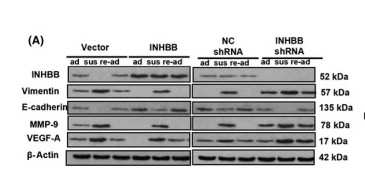
- Zou, Guoying, et al. "Inhibin B suppresses anoikis resistance and migration through the transforming growth factor‐β signaling pathway in nasopharyngeal carcinoma." Cancer science 109.11 (2018): 3416.

- Gu, Yue, et al. "BCL6B suppresses proliferation and migration of colorectal carcinoma cells through inhibition of the PI3K/AKT signaling pathway." International journal of molecular medicine 41.5 (2018): 2660-2668.

- Xiong, Ye, et al. "NOGO-B promotes EMT in lung fibrosis via MMP14 mediates free TGF-beta1 formation." Oncotarget 8.41 (2017): 71024.
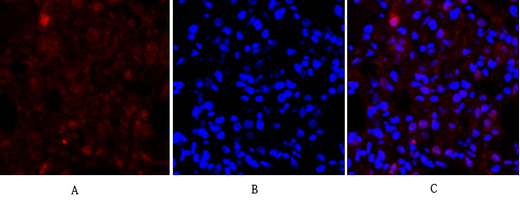
- Immunofluorescence analysis of rat-lung tissue. 1,E-cadherin Polyclonal Antibody(red) was diluted at 1:200(4°C,overnight). 2, Cy3 labled Secondary antibody was diluted at 1:300(room temperature, 50min).3, Picture B: DAPI(blue) 10min. Picture A:Target. Picture B: DAPI. Picture C: merge of A+B
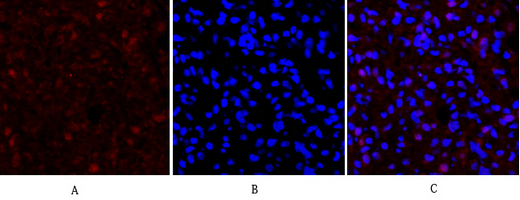
- Immunofluorescence analysis of rat-lung tissue. 1,E-cadherin Polyclonal Antibody(red) was diluted at 1:200(4°C,overnight). 2, Cy3 labled Secondary antibody was diluted at 1:300(room temperature, 50min).3, Picture B: DAPI(blue) 10min. Picture A:Target. Picture B: DAPI. Picture C: merge of A+B
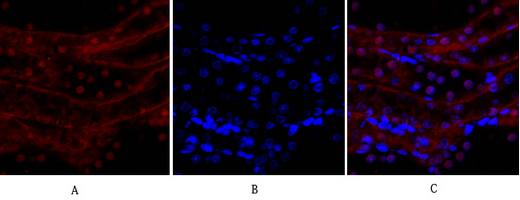
- Immunofluorescence analysis of rat-kidney tissue. 1,E-cadherin Polyclonal Antibody(red) was diluted at 1:200(4°C,overnight). 2, Cy3 labled Secondary antibody was diluted at 1:300(room temperature, 50min).3, Picture B: DAPI(blue) 10min. Picture A:Target. Picture B: DAPI. Picture C: merge of A+B

- Immunofluorescence analysis of rat-kidney tissue. 1,E-cadherin Polyclonal Antibody(red) was diluted at 1:200(4°C,overnight). 2, Cy3 labled Secondary antibody was diluted at 1:300(room temperature, 50min).3, Picture B: DAPI(blue) 10min. Picture A:Target. Picture B: DAPI. Picture C: merge of A+B
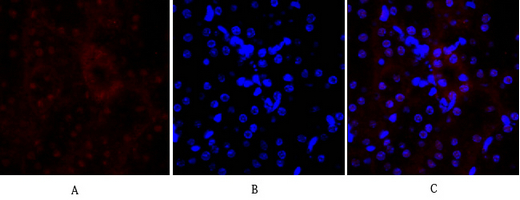
- Immunofluorescence analysis of mouse-kidney tissue. 1,E-cadherin Polyclonal Antibody(red) was diluted at 1:200(4°C,overnight). 2, Cy3 labled Secondary antibody was diluted at 1:300(room temperature, 50min).3, Picture B: DAPI(blue) 10min. Picture A:Target. Picture B: DAPI. Picture C: merge of A+B
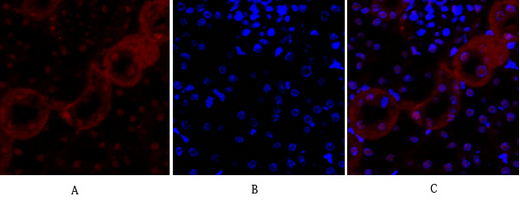
- Immunofluorescence analysis of mouse-kidney tissue. 1,E-cadherin Polyclonal Antibody(red) was diluted at 1:200(4°C,overnight). 2, Cy3 labled Secondary antibody was diluted at 1:300(room temperature, 50min).3, Picture B: DAPI(blue) 10min. Picture A:Target. Picture B: DAPI. Picture C: merge of A+B

- Immunohistochemical analysis of paraffin-embedded Human-liver-cancer tissue. 1,E-cadherin Polyclonal Antibody was diluted at 1:200(4°C,overnight). 2, Sodium citrate pH 6.0 was used for antibody retrieval(>98°C,20min). 3,Secondary antibody was diluted at 1:200(room tempeRature, 30min). Negative control was used by secondary antibody only.
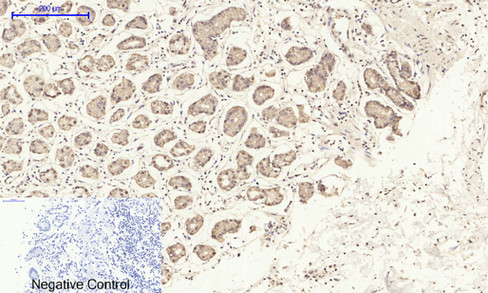
- Immunohistochemical analysis of paraffin-embedded Human-stomach tissue. 1,E-cadherin Polyclonal Antibody was diluted at 1:200(4°C,overnight). 2, Sodium citrate pH 6.0 was used for antibody retrieval(>98°C,20min). 3,Secondary antibody was diluted at 1:200(room tempeRature, 30min). Negative control was used by secondary antibody only.

- Immunohistochemical analysis of paraffin-embedded Rat-heart tissue. 1,E-cadherin Polyclonal Antibody was diluted at 1:200(4°C,overnight). 2, Sodium citrate pH 6.0 was used for antibody retrieval(>98°C,20min). 3,Secondary antibody was diluted at 1:200(room tempeRature, 30min). Negative control was used by secondary antibody only.

- Immunohistochemical analysis of paraffin-embedded Rat-kidney tissue. 1,E-cadherin Polyclonal Antibody was diluted at 1:200(4°C,overnight). 2, Sodium citrate pH 6.0 was used for antibody retrieval(>98°C,20min). 3,Secondary antibody was diluted at 1:200(room tempeRature, 30min). Negative control was used by secondary antibody only.

- Western Blot analysis of 293 cells using E-cadherin Polyclonal Antibody diluted at 1:2000
.jpg)
- Western Blot analysis of HeLa cells using E-cadherin Polyclonal Antibody diluted at 1:2000
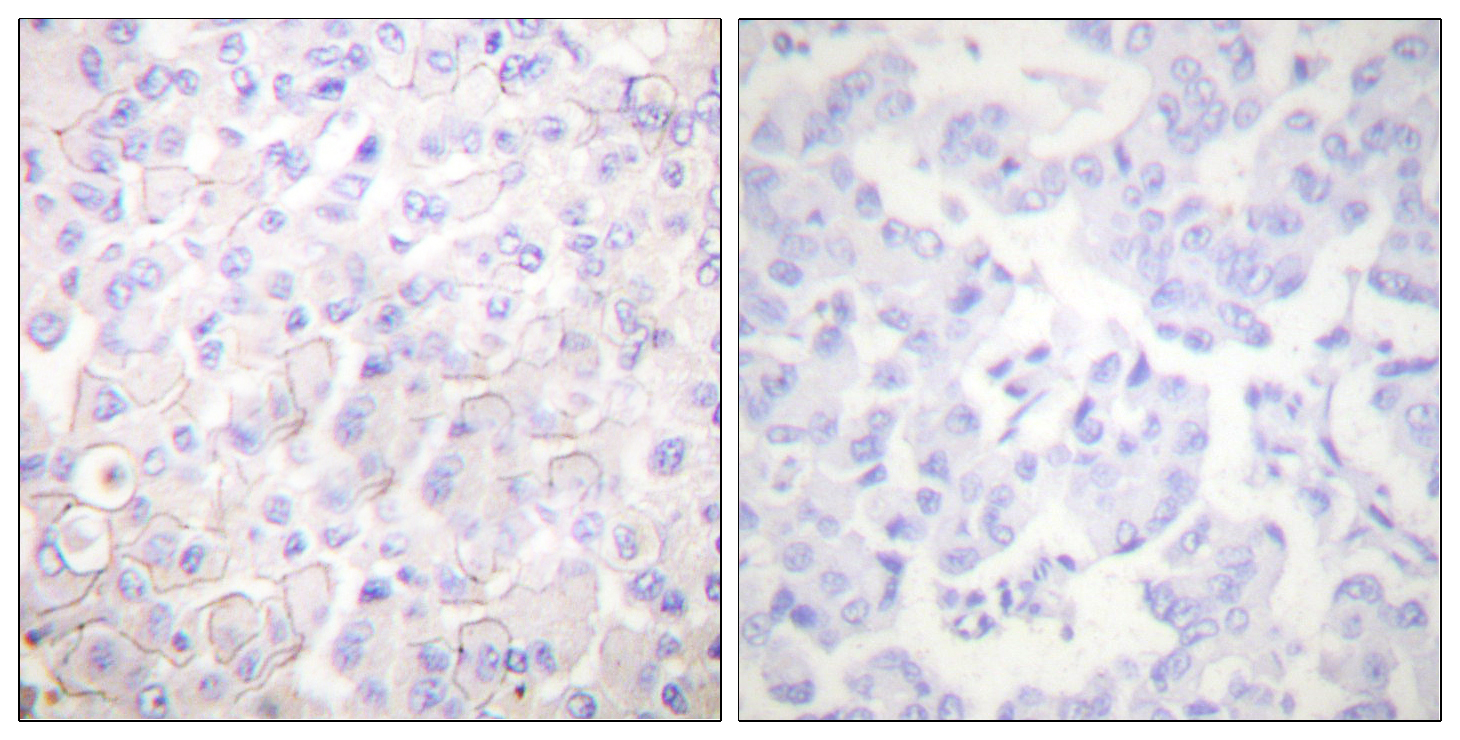
- Immunohistochemistry analysis of paraffin-embedded human breast carcinoma tissue, using Cadherin-pan Antibody. The picture on the right is blocked with the synthesized peptide.

- Western blot analysis of lysates from NIH/3T3 cells, using Cadherin-pan Antibody. The lane on the right is blocked with the synthesized peptide.



